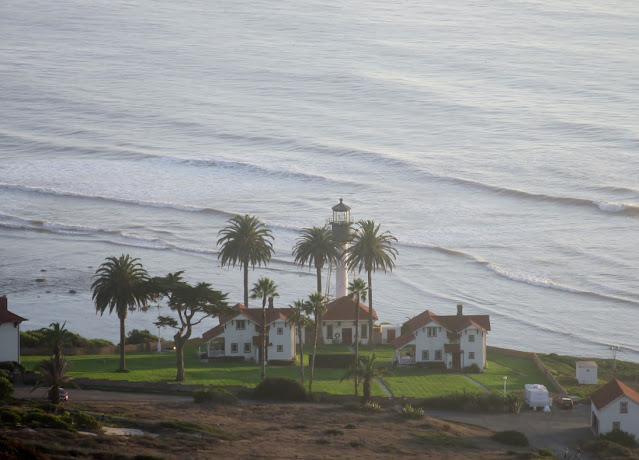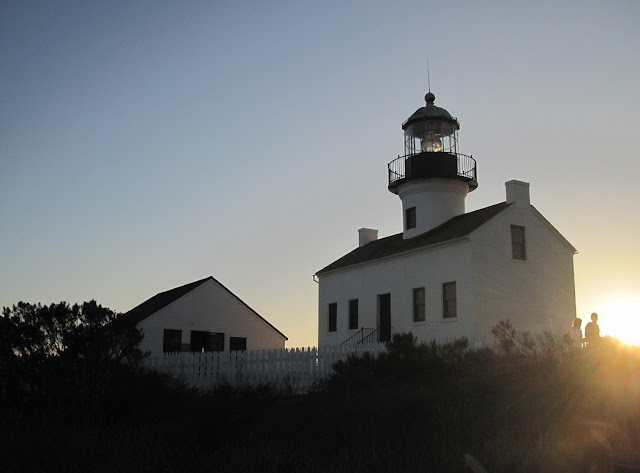Operated by the United States National Park Service, the Cabrillo National Monument commemorates the landing of Spanish explorer Juan Rodriguez Cabrillo at San Diego Bay on 28 September 1542, the first European landfall on the west coast of the United States. The park is located at the southern tip of the Point Loma Peninsula. The Cabrillo National Monument was added to the National Register of Historic Places on 15 October 1966. Offering stunning views of San Diego Bay, Coronado, and the Pacific Ocean, entrance to Cabrillo National Monument costs $5 for a car and its occupants, and includes re-entry good for seven days.
Attractions on the sprawling grounds of the Cabrillo National Monument include a visitor centre and gift shop, a museum on the Spanish expedition of 1542, a statue of Juan Rodriguez Cabrillo, an exhibit on Point Loma's wartime coastal artillery defences, and the Old Point Loma Lighthouse. The Old Point Loma Lighthouse, built in 1855, sits atop the highest point in the park and is furnished as it was when a lighthouse keeper and his family lived in this isolated, windswept location from 1855 to the lighthouse's closure in 1891.
Photos taken 11 January 2014
Below: The Cabrillo National Monument guide handed out to visitors by the National Parks Service.
 |
| The entrance to the Cabrillo National Monument on Point Loma, operated by the US National Park Service. |
 |
| The Cabrillo National Monument Visitor Center, housing exhibits and a gift shop, as well as an observation deck overlooking San Diego Bay. |
 |
| A statue of Portuguese-born Spanish explorer Juan Rodriguez Cabrillo, located at Ballast Point on the Point Loma Peninsula, the spot where Cabrillo is believed to have landed on 28 September 1542. After plans to install a statue of Cabrillo fell through in 1913 and 1926, the Portuguese government commissioned a sandstone statue in 1939 and donated it to the United States. Placed in storage in Oakland, California, State Senator Ed Fletcher arranged to have the statue shipped to San Diego in 1949, where it was again placed in storage on the grounds of the Naval Training Center San Diego. Finally, in 1949, the statue was installed at the Cabrillo Monument. Severely damaged by weather and erosion, the original sandstone statue was replaced in 1988 by a limestone replica. |
 |
| A signboard recounting the landing of Juan Rodriguez Cabrillo and his crew on 28 September 1542, the first Europeans to step foot on the west coast of what would become the United States. |
 |
| The lookout at the Cabrillo National Monument, with wide vistas of San Diego Bay and the Pacific Ocean. |
 |
| A freighter enters San Diego Bay from the Pacific Ocean. Naval Air Station North Island and Coronado can be seen beyond the ship. |
 |
| A closer look at Naval Air Station North Island and the freighter, the Dole Ecuador, a 16,488-ton container ship built in 1989 and registered in Nassau, Bahamas. |
 |
| The Old Point Loma Lighthouse. |
 |
| The Old Point Loma Lighthouse, competed in 1854 at this location, 422 feet above sea level. It took more than a year for the five-foot-tall Fresnel lens to arrive from France, and the lighthouse was not lit for the first time until dusk on 15 November 1855. In clear weather, the light could be seen from 25 miles away. |
 |
| The 3rd Order Fresnel lens previously used by the New Point Loma lighthouse built in 1891. The Fresnel lens was the brainchild of French engineer and scientist Augustin-Jean Fresnel (1788-1827), who revolutionised the understanding of how light behaves and can be manipulated. Fresnel's system of lens optics replaced the system of multiple parabolic reflector and lamp assemblies with a single lamp within a single lens. Today, Fresnel lenses are used in a wide range of applications, including traffic signals, infrared motion detectors, theatre projection systems, photographic equipment, industrial optics, environmental monitoring equipment, astronomical equipment, and automobile lights. |
 |
| A sculpture of a humpback whale sits in front of an actual whale backbone at the Whale Outlook, atop a cliff overlooking the Pacific Ocean at the Cabrillo National Monument. The park is a good spot to watch migrating pods of whales as they travel between the waters off Mexico and Southern California and Alaska. |
 |
| The view down the slope of the Point Loma Peninsula, looking out over the Pacific Ocean. |
 |
| After the closure of the Old Point Loma Lighthouse in 1891, the New Point Loma Lighthouse was built at the bottom of the hill, avoiding the fog and low clouds which often masked the light from the old lighthouse, located 422 feet above. |
 |
| Some of the strange and exotic native species found on the windswept Point Loma Peninsula. A radio antennae on the hill in the distance reminds visitors that the US military still has an active presence on Point Loma. Indeed, the Cabrillo National Monument is located on the grounds of Naval Base Point Loma. |
 |
| Sunset at the Old Point Loma Lighthouse. The high altitude location of the lighthouse posed problems, given the frequency of low clouds and fog, which rendered the light useless. As such, on 23 March 1891, the Old Point Loma Lighthouse was closed and the New Point Loma Lighthouse, located at the bottom of the cliff, began operating. The light in the Old Point Loma Lighthouse was restored by the National Park Service and lit in 1984 to celebrate the park's 130th birthday. Today, the lighthouse is a museum dedicated to showing visitors what life was like for the lighthouse keeper and his family in this cramped, isolated structure. |
 |
| The steep, craggy cliffs of Sunset Cliffs Natural Park on Point Loma. The same day that this photo was taken, 12 January 2014, a 25-year old woman fell 50 feet to her death at this park while watching the sunset. |
 |
| The sun sets over a hazy Pacific Ocean, as seen from Sunset Cliffs Boulevard on Point Loma.
|


















